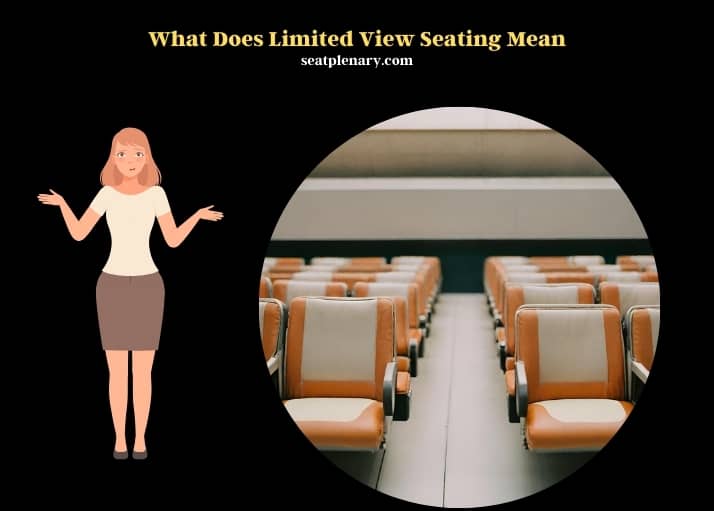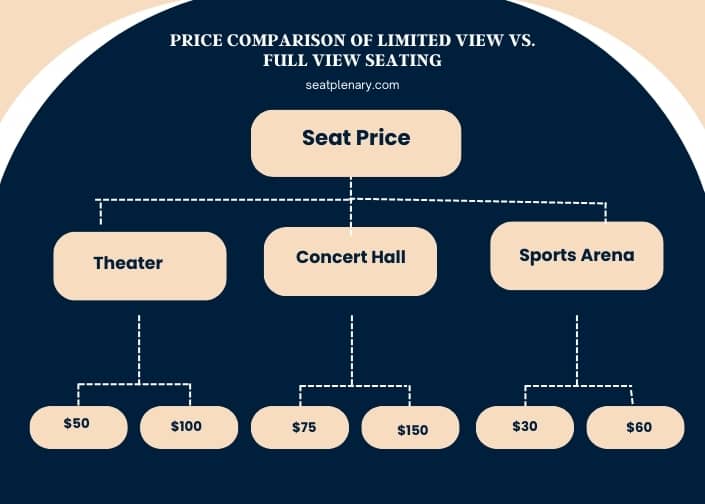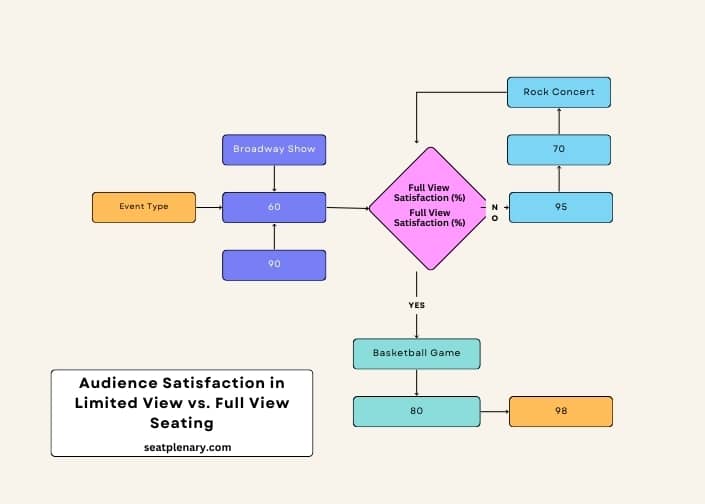Limited view seating refers to seats in a venue where the view of the stage or event is partially obstructed. These obstructions can be due to structural elements, like pillars or balconies, or event-specific setups, such as large stage equipment.
In the realm of entertainment and sports venues, limited view seating is a practical reality. These seats are often integrated into the design of the venue to maximize capacity, ensuring that more people can experience an event, albeit with a compromised view. The nature and degree of obstruction can vary significantly. In some cases, the obstruction might be minimal, slightly affecting the view of a corner of the stage. In other situations, it could be more pronounced, like a significant part of the action being blocked by a structural element.

The pricing of these seats typically reflects their limited view, often being sold at a lower cost than unobstructed seats. This pricing strategy makes events more accessible to a wider audience, accommodating different budget ranges. For many attendees, the opportunity to be part of an event, even with a restricted view, outweighs the disadvantage of not seeing the entire stage.
It’s a trade-off that each attendee must evaluate based on their preferences and the significance of the event. Venues usually disclose the nature of limited view seats at the time of ticket purchase, allowing patrons to make informed decisions.
Limited View Seating in Venues
Limited view seating, a common feature in many entertainment venues, refers to seats that offer a partially obstructed view of the stage or event. The nature of these obstructions can vary widely, from structural elements like pillars or balconies to technical equipment like lighting rigs. This type of seating significantly impacts the overall audience experience. While standard seating offers unobstructed views, limited view seats often result in a less immersive experience.
These seats are integral to venue design, maximizing space and accommodating more guests. The comparison between limited and standard seating is not just about visibility but also about how each type contributes to the venue’s atmosphere and audience satisfaction.
Impact of Limited View Seating on Ticket Pricing
Ticket pricing for limited view seats is a delicate balance of value perception and market dynamics. Venues often price these seats lower than full-view seats, acknowledging the compromised view. This pricing strategy is influenced by factors like the nature of the event, the extent of the obstruction, and overall demand. A comparative analysis with full-view seats shows a consistent trend: limited view seats are typically sold at a reduced price, reflecting their lower value proposition.
During high-demand events, even these seats can fetch higher prices, illustrating the complex interplay of supply and demand in ticket pricing.
Price Comparison of Limited View vs. Full View Seating
| Venue Type | Limited View Seat Price | Full View Seat Price |
| Theater | $50 | $100 |
| Concert Hall | $75 | $150 |
| Sports Arena | $30 | $60 |

Psychological Factors in Choosing Limited View Seats
The decision to opt for limited view seats is not solely based on price; psychological factors play a significant role. Consumers weigh the risk of a partially obstructed view against the reward of experiencing a live event. This decision-making process is influenced by the event’s significance and the individual’s motivation, whether it’s a favorite artist or a once-in-a-lifetime show. The psychological impact of seating choices also extends to post-event satisfaction, where attendees reflect on whether the experience was worth the compromise.
Venue Strategies for Managing Limited View Seating
Venues employ various strategies to address the challenges of limited view seating. Architectural modifications, such as altering seat angles or removing obstructions, are common solutions. Technological enhancements, like screens that relay live feeds, also help improve the experience for those in limited view seats.
Venues focus on customer service, offering transparent information about seat views before purchase and providing exceptional service to compensate for any viewing limitations. Feedback mechanisms are crucial for venues to understand and improve the limited view seating experience continually.
Case Studies on Limited View Seating Management
Examining how different events handle limited view seating offers valuable insights. For instance, a theater may use creative stage design to minimize obstructions, while a sports arena might employ large screens to ensure every moment is visible. These case studies highlight the variety of solutions implemented and their effectiveness. Audience feedback, both positive and negative, drives future improvements and innovations in managing limited view seating.
Audience Satisfaction in Limited View vs. Full View Seating
| Event Type | Limited View Satisfaction (%) | Full View Satisfaction (%) |
| Broadway Show | 60 | 90 |
| Rock Concert | 70 | 95 |
| Basketball Game | 80 | 98 |

Frequently Asked Questions (FAQs)
Are Limited View Seats Always Cheaper?
Limited view seats are generally priced lower than full-view seats due to their obstructed sightlines. The extent of the discount can vary based on the event’s popularity, the venue, and the degree of obstruction. For instance, a slightly obstructed seat at a high-demand concert might be priced closer to a full-view seat, reflecting the high demand. In contrast, a significantly obstructed seat at a less popular event might be much cheaper. The pricing reflects a balance between the quality of the view and the desire to fill all seats.
What Types of Obstructions Cause Limited View Seating?
Obstructions in limited view seating can range from architectural features like columns or railings to production elements like lighting rigs or sound equipment. In some venues, the angle of seating or the distance from the stage can also limit the view. The nature of the obstruction often depends on the venue’s design and the event’s setup. For example, in an old theater, structural pillars might block views, while in a modern concert hall, stage equipment or the angle of seating could be the issue.
Can You Request a Seat Change if Unsatisfied with the View?
If you’re dissatisfied with the view from a limited view seat, requesting a seat change is possible but not guaranteed. It largely depends on the venue’s policy and the availability of other seats. Some venues might accommodate requests if there are unsold seats available, while others may have a no-exchange policy. It’s always best to inquire about the venue’s policy at the time of purchase and to arrive early if seeking a seat change.
How Do Venues Disclose Limited View Seating?
Venues typically disclose limited view seating through their ticketing platforms. These seats are often labeled as “limited view,” “restricted view,” or similar terminology. Some venues provide detailed descriptions or photos showing the extent of the obstruction. This transparency helps customers make informed decisions.
The level of detail and clarity in disclosure can vary, so it’s advisable to research or contact the venue for more information if unsure.
Is Limited View Seating Worth It for Big Events?
Whether limited view seating is worth it for big events depends on personal preferences and the event’s significance. For some, being present at a major event, even with a compromised view, is valuable. Fans of a specific artist or team, or those attending a once-in-a-lifetime event, might find the trade-off acceptable. Others might prioritize a clear view to fully enjoy the experience. It’s a personal decision based on factors like event significance, budget, and individual preferences.
Do All Venues Have Limited View Seating?
Most large venues have some form of limited view seating due to structural and design constraints. The extent and nature of these seats vary widely. Older venues, like historic theaters, are more likely to have structural obstructions, while modern venues might have limited view seats due to the staging of specific events. Smaller venues might have fewer issues with obstructed views. It’s a common aspect of venue design, aimed at maximizing capacity while navigating architectural limitations.
Conclusion
Limited view seating presents unique challenges and opportunities for venues and attendees alike. From the pricing strategies and psychological factors influencing ticket purchases to the innovative solutions venues implement, understanding the dynamics of limited view seating is crucial. This analysis not only sheds light on the practical aspects of such seating arrangements but also underscores the importance of customer satisfaction in the entertainment industry.
